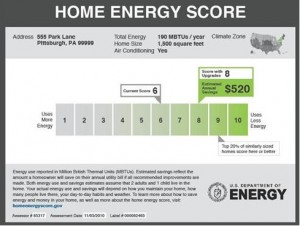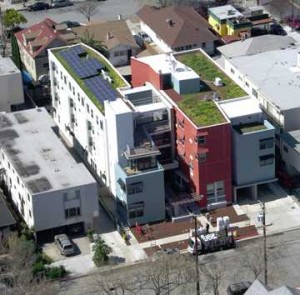Posts Tagged Green
86% of Building Construction Expenditures Relate to Renovation of Existing Buildings
Posted by Jim Foster in BIM, Built Environment, economic trends, Energy Analysis, Green, Sustainable Retrofits on February 18, 2013
 “As ASHRAE President Gordon V.R. Holness noted in the ASHRAE Journal, “Approximately 86% of building construction expenditures relate to renovation of existing buildings, not to new construction.” Holness estimated that “over the next 30 years about 150 billion sf of existing buildings (roughly half of the entire building stock in the United States) will need to be renovated.” Historically, new construction only adds about 2% annually to the U.S. commercial building stock, so the real opportunities for reducing operating costs must be found in building retrofit and renovation.” – Glumac Blog.
“As ASHRAE President Gordon V.R. Holness noted in the ASHRAE Journal, “Approximately 86% of building construction expenditures relate to renovation of existing buildings, not to new construction.” Holness estimated that “over the next 30 years about 150 billion sf of existing buildings (roughly half of the entire building stock in the United States) will need to be renovated.” Historically, new construction only adds about 2% annually to the U.S. commercial building stock, so the real opportunities for reducing operating costs must be found in building retrofit and renovation.” – Glumac Blog.
Buildings are the major source of global demand for energy and materials that produce by-product greenhouse gases (GHG). Slowing the growth rate of GHG emissions and then reversing it is the key to addressing climate change and keeping global average temperature below 2°C above pre-industrial levels.
To accomplish this, Architecture 2030 issued The 2030 Challenge asking the global architecture and building community to adopt the following targets:
- All new buildings, developments and major renovations shall be designed to meet a fossil fuel, GHG-emitting, energy consumption performance standard of 60% below the regional (or country) average/median for that building type.
- At a minimum, an equal amount of existing building area shall be renovated annually to meet a fossil fuel, GHG-emitting, energy consumption performance standard of 60% of the regional (or country) average for that building type.
- The fossil fuel reduction standard for all new buildings and major renovations shall be increased to:
- 70% in 2015
- 80% in 2020
- 90% in 2025
- Carbon-neutral in 2030 (using no fossil fuel GHG emitting energy to operate).
These targets may be accomplished by implementing innovative sustainable design strategies, generating on-site renewable power and/or purchasing (20% maximum) renewable energy.
Please visit Frequently Asked Questions section for more in-depth information on the 2030 Challenge.
******
*Note: This was stated in the January 2008 Edition of the ASHRAE Journal. When we polled permitting for Boston, we found 75% for construction in Existing Buildings. 25% New.
IFMA Releases Sustainability Guide and Carbon Footprint Measuring Guidelines for Buildings
Posted by Jim Foster in BIM, New Technologies, Smart Building, Sustainable Retrofits on May 1, 2012
 IFMA (International Facility Management Association) the leading association for facility managers released a Sustainability Guide and Measuring Guidelines for determining a buildings footprint. Buildings which account for around 40% of energy usage are perhaps the biggest consumers of fossil fuels and producers of carbon. In order to understand how buildings are consuming energy, creating carbon and determining ways to manage and reduce it IFMA published the guide and it is available for free.
IFMA (International Facility Management Association) the leading association for facility managers released a Sustainability Guide and Measuring Guidelines for determining a buildings footprint. Buildings which account for around 40% of energy usage are perhaps the biggest consumers of fossil fuels and producers of carbon. In order to understand how buildings are consuming energy, creating carbon and determining ways to manage and reduce it IFMA published the guide and it is available for free.
According to the guide and referencing a report from Groom Energy Solutions and Pure Strategies highlights the top five drivers that motivate a business to track and report carbon:
- Improved company/brand image
- Requests from top customer
- Investor pressure
- GHG regulation
- Cost savings
(Groom Energy Solutions 2010)
While surprising to me that cost savings is at #5 I think as more and more positive ROI cases are published people will realize that a path to sustainability brings more profits due to reduced operating costs. Looks to me though that the role of the FM is going to get more glamorous, and those skilled in this art should be in high demand.
Building Energy Analysis : A smorgasbord
Posted by Jim Foster in As Builts, Autodesk, BIM, Energy Analysis, Energy Modeling on April 11, 2012
 This is the case the more I learn about it, the less I know. As energy analysis picks up as a real tool in the trades, not just for sustainable retrofits, but to provide the data for financing as well and people working it from combing demographic information with utilities, to engineers, and beyond the amount of tools out there starts to become staggering…and I am sure I will be missing plenty. But half of this excercise is to get input from anyone reading this to what they are using and why. And am encouraging smack talk to why one is better than another. What follows is a completely non-exhaustive list of stuff I’ve been running into and in no particular order. For a more exhaustive list without editorial comments the DOE (Department of Energy) maintains this List.
This is the case the more I learn about it, the less I know. As energy analysis picks up as a real tool in the trades, not just for sustainable retrofits, but to provide the data for financing as well and people working it from combing demographic information with utilities, to engineers, and beyond the amount of tools out there starts to become staggering…and I am sure I will be missing plenty. But half of this excercise is to get input from anyone reading this to what they are using and why. And am encouraging smack talk to why one is better than another. What follows is a completely non-exhaustive list of stuff I’ve been running into and in no particular order. For a more exhaustive list without editorial comments the DOE (Department of Energy) maintains this List.
- EQuest – Straight out of the DOE, and while their website looks like it was designed in 1998, the claim is “Imagine a building energy simulation tool comprehensive enough to be useful to ALL design team members, yet so intuitive ANY design team member could use it” And I know people out there using it.
- BEopt – Straight out of NREL (National Renewable Energy Laboratory) – Now this seems to have some limitations and uses the DOE 2.2 engine, just as eQuest does however, one thing that popped out is the fact that you cannot call out different wall types or change sill heights to windows, which seems very limiting, yet, people are out there using it.
- EnergyPlus : ” is a whole building energy simulation program that engineers, architects, and researchers use to model energy and water use in buildings”
- The Autodesk Family
- Green Building Studio – This a web based service that allows for a variety of analysis including:
- Whole Building Energy Analysis
- Carbon Emissions : Footprint
- Weather Analysis
- Design Alternatives
- Water Usage
- Energy Star Scoring
- GBS uses gbXML and is interoperable with Revit and….yes the DOE 2.2 Engine.
- Ecotect : How this is different than GBS, I don’t know, but if you buy Ecotect you get GBS along with it..but both have similar claims.
- Vasari : More energy analysis but at the design concept stage
- Google : Sketch Up Family
- IES Plug In – Allows you to apply materials onto a Sketch Up model for import into an IES tool
- Energy Plus Open Studio Plug In – All the EnergyPlus option through your SketchUp model
- GreenSpace Modeler : Allows you to apply gbmxl textures to a sketchup model for import into a gbmxl tool for analysis like Green Building Studio
An excellent resource I found through WBDG is the a summary of Energy Analysis Tools, including DOE 2.2, BLAST, EnergyPlus, and the like. Plus there is a whole list of BLCCs (Building Lifecycle Cost) Programs.
I guess the point is just when you think BIM is going to solve everything with a push button, no matter which ecosphere you live in, be it Autodesk, Archicad, etc. there are tool sets out there, and more importantly ‘free’ tool sets out there that get a lot of play. What worksflows and tools are you using for building / energy analysis?
Flaring Off A Finite Resource : North Dakota Natural Gas best used to heat the outdoors.
Posted by Jim Foster in Green on September 27, 2011
 Listen, I am a capitalist and have recently become a big fan of the Carbon War Room which creates market based solutions for creating climate change, that is, let’s create something that reduces our reliance on fossil fuels and makes money all at the same time, in fact, let’s stop relying so much on the extraction of oil from the most politically unstable places on earth, that would be a good thing as well. So reading today’s NY Times “In North Dakota, Flames of Wasted Natural Gas Light the Prairie” I get a little worked up.
Listen, I am a capitalist and have recently become a big fan of the Carbon War Room which creates market based solutions for creating climate change, that is, let’s create something that reduces our reliance on fossil fuels and makes money all at the same time, in fact, let’s stop relying so much on the extraction of oil from the most politically unstable places on earth, that would be a good thing as well. So reading today’s NY Times “In North Dakota, Flames of Wasted Natural Gas Light the Prairie” I get a little worked up.
Every day, more than 100 million cubic feet of natural gas is flared this way — enough energy to heat half a million homes for a day.
Really, WTF. I’m sure the companies operating would love to capture the gas to sell but as mentioned in the article the infrastructure is not there to capture it, pipelines and processing. So let’ s look at the math
Natural Gas is running at the about $4.00 per 1,000 cubic feet at the wellhead, and they are running 100 million cubic feet a day so 100 Million/1,000 * $4.00 = $400,000. (multiplied by 365) = $146 Million Dollars per year.
WTF. And this is just from the commodity straight from the well head it does not count the economic impact of a new natural gas facility and the margins made by in between, etc. Okay I am sure an infrastructure project to capture all this is not cheap, but talk about a shovel ready project with a revenue stream able to pay off investors. But in a bid to extract as much oil as possible from the Bakken Field in North Dakota through hydraulic fracturing and horizontal drilling more and more and more gas will be released as a byproduct.
Why flare, because it’s easier and cheaper while extracting the more “valuable” oil from the fields. So while scientist try to figure out how extract energy from wood pulp and the sun, algae and the like myopia continues to claim more victims as we burn a precious, finite resource because it’s convenient. Let’s put even more people to work in North Dakota building the infrastructure in a planned and smart way. Wayne Schafer is quoted at the end of the article saying, “You can do it fast or you can do it right.” or I’ll quote one of the construction managers we’ve done work for, “You can do something no ass, or you can do something full ass, just don’t do it half ass”
“Rocket” science applied to buildings : NASA BIM
Posted by Jim Foster in BIM, New Technologies on September 26, 2011
 Excerpted from the NASA Press Release: NASA Partners with DOE to Construct ‘Greenest’ Federal Building
Excerpted from the NASA Press Release: NASA Partners with DOE to Construct ‘Greenest’ Federal Building
MOFFETT FIELD, Calif. – NASA’s Ames Research Center and the Department of Energy (DOE), at the Lawrence Berkeley National Laboratory, Berkeley, Calif. are collaborating on technologies and processes for what may be the “greenest,” highest-performing building in the federal government.
Originally developed for aerospace applications, NASA intelligent system software will be installed in the new building, called Sustainability Base, by Ames engineers. These NASA-developed control and Integrated Systems Health Management (ISHM) technologies will be an integral part of the building. To help integrate these “smart system” technologies, the Building Technologies Department at Berkeley Lab developed a Building Information Model (BIM) to serve as the repository for the building’s systems information during its life cycle. Using data from the BIM, Berkeley Lab developed an energy-performance simulation model to optimize the building’s energy operations.
For more information about Sustainability Base, please visit: http://www.nasa.gov/centers/ames/greenspace/sustainability-base.html
For more information about NASA Ames, visit: http://www.nasa.gov/ames/
For more information about Integrated Building Solutions, Inc., please visit: http://www.ibs-cal.com/
For more information about LBNL’s Building Science program visit: http://eetd.lbl.gov
Unlocking the Multi-Billion Building Retrofit Market from the Carbon War Room : #BIM
Posted by Jim Foster in Built Environment, retrofit on September 21, 2011
The Carbon War Room harnesses the power of entrepreneurs to implement market-driven solutions to climate change. The world needs entrepreneurial leadership to create a post-carbon economy.
The War Room’s unique approach focuses on bringing together successful entrepreneurs, business leaders, policy experts, researchers, and thought leaders to focus on market-driven solutions. -www.carbonwarroom.com
Anyone who read the times article yesterday and from their own web site saw that these guys are putting a wrapper around Retrofits , from the engineering to the financing that can be sold as bonds with a 7% return mainly paid from the savings incurred from the retrofit projects, has to love this approach. It puts people back to work, it saves energy and dollars, and it provides a return on capital for those invest in it, awesome. One has to imagine that more financial institutions looking to bundle, promote, sell new products is going to love this. From ‘green’ investors down the line. There’s a job recovery program for you.
Green Capital Global Challenge from Carbon War Room on Vimeo.
Financing coming together for Green Building Initiatives : Consortium put together by The Carbon War Room
Posted by Jim Foster in Built Environment, Green on September 20, 2011
 So you want to retrofit a building. Everything is in place, the ROI calculations, the press for promoting your green building, possibly higher SF Lease Rates because of the Green Building, plus you’ll be saving money from it, less green house gases, less dependence on fossil fuel, etc. The one thing missing, no matter how much it makes sense, the financing. Excellent article in the NY Times, Tax Plan to Turn Old Buildings ‘Green’ Finds Favor, explaining the current model which would be in the form of bonds sold to investors. “The consortium was put together by the Carbon War Room, a nonprofit environmental group based in Washington set up by Richard Branson, the British entrepreneur”, what doesn’t this guy do.
So you want to retrofit a building. Everything is in place, the ROI calculations, the press for promoting your green building, possibly higher SF Lease Rates because of the Green Building, plus you’ll be saving money from it, less green house gases, less dependence on fossil fuel, etc. The one thing missing, no matter how much it makes sense, the financing. Excellent article in the NY Times, Tax Plan to Turn Old Buildings ‘Green’ Finds Favor, explaining the current model which would be in the form of bonds sold to investors. “The consortium was put together by the Carbon War Room, a nonprofit environmental group based in Washington set up by Richard Branson, the British entrepreneur”, what doesn’t this guy do.
As excerpted from the Article:
Short-term loans provided by Barclays Capital will be used to pay for the upgrades. Contractors will offer a warranty that the utility savings they have promised will actually materialize, and an insurance underwriter, Energi, of Peabody, Mass., will back up that warranty. Those insurance contracts, in turn, will be backed by Hannover Re, one of the world’s largest reinsurance companies.
As projects are completed, the upgrade loans, typically carrying interest rates of 7 percent, will be bundled into long-term bonds resembling those routinely issued by governmental taxing districts. Barclays will market the bonds. Retirement funds have expressed interest in buying these bonds, which will be repaid by tax surcharges on each property that undergoes a retrofit.
This all is just starting to make too much sense.
Obama Administration Boosts Retrofits : Biden Announces Fed Program
Posted by Jim Foster in BIM, Built Environment, Sustainable Retrofits on November 12, 2010
 Am I calling it or what? As reported by Martin LaMonica on CNET and the Steven Thomma of the Miami Herald Vice President Joe Biden with US Department of Energy Secretary Steven Chu on Tuesday unveiled a new federal program to make it easier for Americans to make their homes more energy efficient, saying it will help people save money and create new jobs for contractors.
Am I calling it or what? As reported by Martin LaMonica on CNET and the Steven Thomma of the Miami Herald Vice President Joe Biden with US Department of Energy Secretary Steven Chu on Tuesday unveiled a new federal program to make it easier for Americans to make their homes more energy efficient, saying it will help people save money and create new jobs for contractors.Excerpts for the release below:
“The initiatives announced today are putting the Recovery Through Retrofit report’s recommendations into action – giving American families the tools they need to invest in home energy upgrades.” said Vice President Biden. “Together, these programs will grow the home retrofit industry and help middle class families save money and energy.”
“The Home Energy Score will help make energy efficiency easy and accessible to America’s families by providing them with straightforward and reliable information about their homes’ energy performance and specific, cost-effective energy efficiency improvements that will save them money on their monthly energy bills,” said Secretary Chu.
Under this voluntary program, trained and certified contractors will use a standardized assessment tool developed by DOE and Lawrence Berkeley National Laboratory to quickly evaluate a home and generate useful, actionable information for homeowners or prospective homebuyers. With only about 40 inputs required, the Home Energy Scoring Tool lets a contractor evaluate a home’s energy assets, like its heating and cooling systems, insulation levels and more, in generally less than an hour. That means a homeowner can see how their home’s systems score, regardless of whether a particular homeowner takes long or short showers or keeps their thermostat set high or low.
The following states and municipalities are participating in the pilot program: Charlottesville, Virginia; Allegheny County, Pennsylvania; Cape Cod and Martha’s Vineyard, Massachusetts; Minnesota; Omaha and Lincoln, Nebraska; Indiana; Portland, Oregon; South Carolina; Texas; and Eagle County, Colorado. Learn more about each of the testing locations along with details on how to participate in the Home Energy Score program.
Consumers can apply for up to $25,000 in PowerSaver loans through the U.S. Department of Housing and Urban Development, which expects that 24,000 homes will qualify during a two-year pilot program, according to USA Today.
This home energy retrofit program follows a $5 billion weatherization investment that was part of the stimulus package last year. Another effort is Home Star, nicknamed Cash for Caulkers, which would provide rebates to consumers for investing in energy efficiency retrofits.
Read more: http://news.cnet.com/8301-11128_3-20022184-54.html#ixzz155UA7FTa
How does this effect BIM users/developers, etc.?
Commercial deployment will be huge and has more robust documentation and reporting needs, plus these firms getting into it will need to have better tools, etc as the race begins to fill these needs and to differentiate themselves from competition, imagine a 3D BIM model with all the reporting built into it. I have to imagine the plug ins are already under development. Additionally, did you notice the certification needs recommended for this. Strap it on, let’s get back to work.
Green BIM : Everybody’s Doing It
Posted by Jim Foster in BIM, Green on October 25, 2010
 As reported recently in the Wall Street Journal, ‘Turning Consumers Green‘ the best tactic is peer pressure. From reducing plastic bag use to turning off the shower. You might ask, who’s going to pressure me in the shower. Fair enough, but this is in a locker room setting where they stated when a sign was posted to turn off the shower when soaping there was 6% compliance but if there was a plant, as in a person who they planted there to turn off water when they soaped, compliance rocketed to 47%. (Sidebar: How do they advertise this job and who applies or volunteers for that particular task.) But how does this impact you rather than reemphasizing people are sheep? Well if you can identity a trend that gains this kind of traction because of the peer pressure you don’t have to look far out into our industry before you find BIM and the emerging strength of Green BIM and rapid energy modeling. In a recent MCGraw Hill Smart Market Report, Green BIM the cited the growth of sustainable retrofits that are green will increase from 5-9% currently to 20-30% in 2014. Huge growth in energy simulation is expected in this market with the top 3 being:
As reported recently in the Wall Street Journal, ‘Turning Consumers Green‘ the best tactic is peer pressure. From reducing plastic bag use to turning off the shower. You might ask, who’s going to pressure me in the shower. Fair enough, but this is in a locker room setting where they stated when a sign was posted to turn off the shower when soaping there was 6% compliance but if there was a plant, as in a person who they planted there to turn off water when they soaped, compliance rocketed to 47%. (Sidebar: How do they advertise this job and who applies or volunteers for that particular task.) But how does this impact you rather than reemphasizing people are sheep? Well if you can identity a trend that gains this kind of traction because of the peer pressure you don’t have to look far out into our industry before you find BIM and the emerging strength of Green BIM and rapid energy modeling. In a recent MCGraw Hill Smart Market Report, Green BIM the cited the growth of sustainable retrofits that are green will increase from 5-9% currently to 20-30% in 2014. Huge growth in energy simulation is expected in this market with the top 3 being:
- Whole Building Energy Use
- Lighting and Day Lighting
- Energy Code Compliance
This type of analysis is right in BIM’s wheelhouse as seen in Revit CEA. However, one of the biggest issues still remains software integration, that is one model, many uses rather than everyone building their own model for their own uses. So look for more companies trying to either build functionality on top of existing platforms or creating translation or integration tools.
Look for Green to expand. It’s not for just Organic Folks eating Birkenstocks at their local markets as it is starting to make too much sense. For example, Casa Feliz Apartments in San Jose and as reported by Robbie Whelan in the Wall Street Journal, ‘utilized bamboo floors, linseed oil based linoleum and ergonomic chairs in the lobby made from sustainability farmed wood.’ Addtionally,
Casa Feliz is one of a growing number of affordable-housing projects nationwide that have been built “green”—that is, with nontoxic materials, highly energy-efficient appliances, and features such as green roofs and solar panels. Thanks to tax credits designed to attract private capital and aggressive cost-cutting on other construction features, affordable-housing developers are embracing eco-friendly building features that were once the purview of high-minded designers and wealthy developers with money to spare.
MetLife Inc., the big New York-based insurance company, is one of those investors. Matt Sheedy, who invests funds from MetLife’s $325 billion general account, says MetLife and other large institutional investors are eager to invest in green affordable-housing projects because they have a safer risk profile than more traditional housing projects.
So either get caught by the wave, or build your boat out of sustainable wood, hoist your hemp sail and get going. Your firm needs a Green BIM strategy.
Greening the Built Environment : Autodesk joins IBM’s Green Sigma Coalition : IBM Flexing its Market Power Muscle : BIM
Posted by Jim Foster in BIM, Built Environment on October 5, 2010
 Quick jumble from IBM to BIM and it seems a lot of threads are coming together between IBM and the AECOM community. Smart Buildings and Smart Cities, IBM and Dassault, IBM Maximo, etc. How this comes to grind with LEED, and EnergyStar initiatives , etc remains to be seen but there is quite a roster to this invite only list. Charter members include: Johnson Controls, Honeywell Building Solutions, ABB, Eaton, ESS, Cisco, Siemens Building Technologies Division, Schneider Electric and SAP but nothing like owning the process and selling services, hardware, software, product to achieve Green Sigma. The process itself :
Quick jumble from IBM to BIM and it seems a lot of threads are coming together between IBM and the AECOM community. Smart Buildings and Smart Cities, IBM and Dassault, IBM Maximo, etc. How this comes to grind with LEED, and EnergyStar initiatives , etc remains to be seen but there is quite a roster to this invite only list. Charter members include: Johnson Controls, Honeywell Building Solutions, ABB, Eaton, ESS, Cisco, Siemens Building Technologies Division, Schneider Electric and SAP but nothing like owning the process and selling services, hardware, software, product to achieve Green Sigma. The process itself :
“Combines real-time metering and monitoring with advanced analytics and dashboards that allow clients to make better decisions that improve efficiency, lower costs and reduce environmental impact.”
IBM goes on to outline the validation process which is, you guessed it, validated by IBM. How this differs from LEED which:
… is an internationally recognized green building certification system, providing third-party verification that a building or community was designed and built using strategies aimed at improving performance across all the metrics that matter most: energy savings, water efficiency, CO2 emissions reduction, improved indoor environmental quality, and stewardship of resources and sensitivity to their impacts.
Now I am a capitalist so increasing shareholder value is something I take to heart, sure there’s a lot more in the mix than that and who am I to take IBM to task for flexing its market power muscle but aren’t we talking the same side of the coin only IBM wants to own the coin too. One could argue that Green Sigma is the practical application of LEED principles. That should keep respective communication departments off my back. Regardless of who owns the process the end goal for each is laudable, and now proven that ‘green’ is good business.
As reported by Lauren Browne at Connect Press IBM brought Autodesk in for its expertise in modeling and the built environment.
“It occurred to IBM, that it would make sense, given that the built environment requires multiple layers of solution sets including hardware, software, services, financing, etc. that no one company could do this (tackle greening the built environment) in isolation. And if they did, they would be handicapping themselves.” – Emma Stewart, Senior Program Lead, Sustainability, Autodesk.
This could help explain the Photofly and PointCloud tools expected in the most recent release of Autocad but if you start doing the math, +$400 billion in sustainable retrofits, +75% of construction done in the built environment you understand why the big guns are out.

